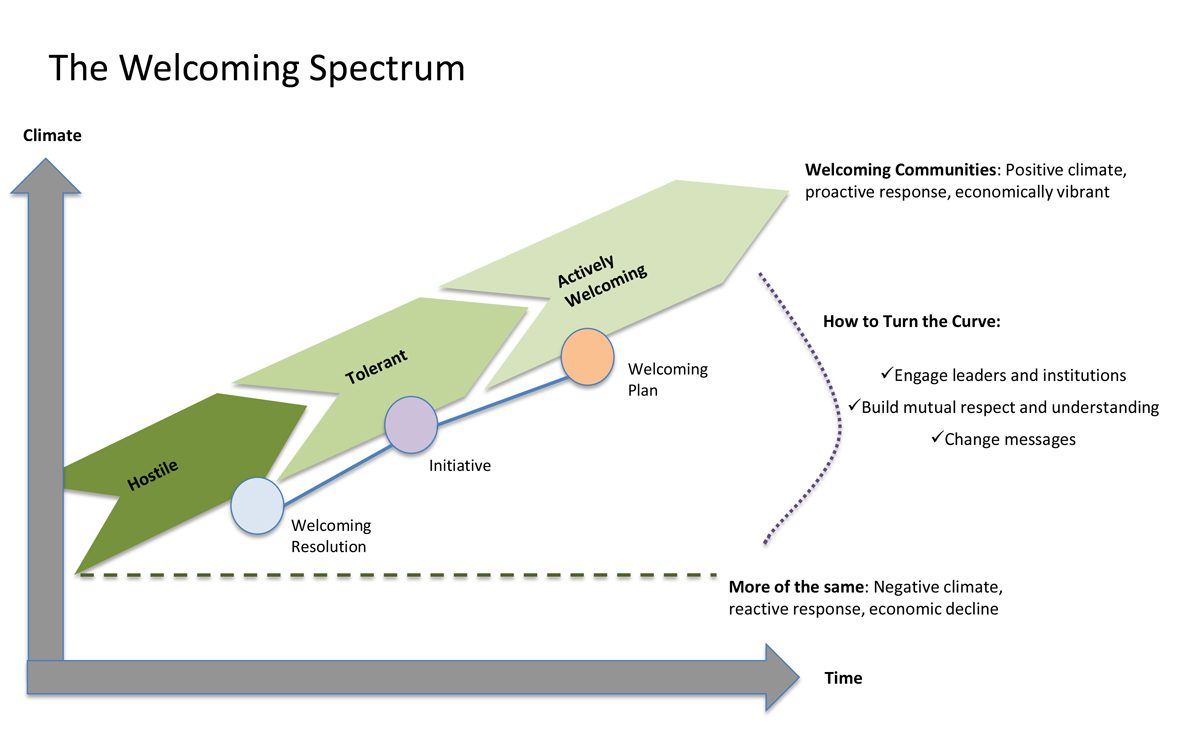For our future: Make Charlotte a welcoming city

The last five years have been among the most challenging in the nearly 250-year history of Charlotte. The Great Recession erased the mythology that our community was invulnerable to the vicissitudes of national economic fortunes.
Home construction, property values, business investment, and community philanthropy plunged downward at rates not seen since the Depression. Unemployment rates in Mecklenburg County, typically among the lowest in North Carolina, climbed to levels close to the rates in rural, traditionally poorer locales in eastern and western parts of the state.
We are finally seeing the long-awaited economic recovery slowly build momentum. During the last several years, Charlotte was the fifth-fastest growing metro area in the country. Permits for new single-family housing in Mecklenburg County (2012) are ahead of 2008 levels by 28 percent. And employment in the Charlotte metropolitan region is now above pre-recession levels.
What lessons can we take from the recent turmoil? What can we do to better position our city and county for sustained economic growth and positive change? The answer, I believe, comes by preparing Charlotte to take advantage of the 21st–century economy.
But how? Across the globe, strategic thinking cities and urban regions are working to actively attract capital, entrepreneurs, and innovators from other parts of the world. Whether in Shanghai, Frankfurt, or Palo Alto, the focus is the same: How do we make our city welcoming to immigrants?
Evidence shows immigrants boost jobs
The economic facts are overwhelming: Immigrants are job creators. They are 30 percent more likely to start a business. Research shows increased immigration produces higher earnings for all workers. A recent study from the National Venture Capital Association reported that publicly traded businesses started by immigrants with venture funds have a total market capitalization of $900 billion and employ 600,000 people in the U.S. and around the world. These include some of America’s leading corporate innovators, like Google, Intel, LinkedIn, eBay, and Facebook.
Immigrants are key innovators powering America’s technological economy. Consider, in 2011, foreign-born inventors were credited with 25 percent of the patents issued in top university laboratories.
More important for the future, the pipeline for new scientists and technologists relies heavily on foreign students. A 2011 National Science Foundation survey reported more than half the Ph.D. graduates in American universities in electrical engineering, industrial engineering, mechanical engineering, materials engineering, chemical engineering, and computer science were awarded to international students. The bottom line: America’s continued global leadership in sophisticated technological and engineering-based businesses is immigrant-centered.
Immigrants bring significant purchasing power, spurring demand for local consumer goods, leading the way in the revitalization of declining neighborhood business districts and boosting residential development. Not unexpectedly, economic researchers have found that U.S. metropolitan regions with the fastest economic growth had urban centers with higher increases in the immigrant workforce. Simply put, immigration and economic growth go hand in hand.
Through local programs like the Mayor’s International Cabinet and the Charlotte Regional Partnership, Charlotte and our region promote themselves as globalizing and encouraging to international ties. The growing number of international businesses locating offices and manufacturing facilities in the Charlotte-centered region is evidence that we are on the global business map. But attracting overseas investments is only part of the model. The strongest opportunities come with attracting human capital; that means making this an immigrant-receptive community.
How receptive to newcomers is Charlotte?
Today, most Charlotteans and Mecklenburg County residents believe this is a receptive community to international newcomers regardless of their national origin or immigration status. The UNC Charlotte Urban Institute’s 2013 Charlotte-Mecklenburg Annual Survey asked local residents about their attitudes toward different nationalities and immigration status. The overwhelming proportion, 65 percent, felt our city and county were welcoming. But nearly one in five Latino/Hispanic respondents (19 percent) disagreed, and 31 percent took a neutral position. Clearly Latino residents in Mecklenburg do not support the larger optimistic ethos. Their contrasting perspective should concern us.
On a three-part scale ranging from unwelcoming to tolerant to actively welcoming, Charlotte falls into the middle category, with a benign response to immigrants and offering incremental programs and activities for newcomers but no concerted welcoming plan.
Charlotte needs to move to the top category.

This would require a community-wide engagement strategy to make us actively welcoming to immigrants. We are falling behind peers like Austin, Texas; Boston; Houston and the Triangle. Those are places where community leaders and corporate partners are coming together to craft initiatives to promote a welcome environment, one that will create the most opportunity for immigrant settlement and integration.
What can we do to make Charlotte and Mecklenburg County attractive to immigrants? We can draw on lessons from other cities and regions. A framework and organizational support structure is already in place. “Welcoming America” – a nationwide collaboration of cities and counties in 20 states – helps local governments, business leaders, and citizen groups promote immigrant settlement and integration.
Learning from other cities, we can develop a Charlotte-oriented plan to maximize opportunities for immigrant economic participation, cultural vitality, and civic engagement.
The 20th-century economic development paradigm was for cities and counties to compete for a single, large, new manufacturing plant with financial enticements. But that approach will not position Charlotte for sustained growth and economic prosperity. Instead, we should create a framework of public and private activities to make Charlotte a top attraction for immigrants from around the world. That will make our community a better place – for Charlotteans old and new.
Owen Furuseth is associate provost for Metropolitan Studies and Extended Academic Programs and a professor of geography at UNC Charlotte.
Views expressed in commentary articles here do not necessarily represent the views of the UNC Charlotte Urban Institute or the University of North Carolina at Charlotte.